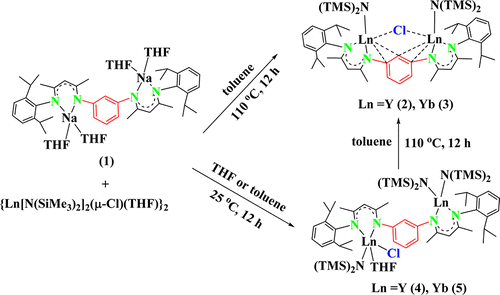Unexpected C–H Bond Activation Promoted by Bimetallic Lanthanide Amido Complexes Bearing a META-Phenylene-Bridged Bis(β-diketiminate) Ligand
Song Sun †, Qiu Sun †, Bei Zhao *†(赵蓓), Yong Zhang †, Qi Shen †, and Yingming Yao *†‡(姚英明)
† Key Laboratory of Organic Synthesis of Jiangsu Province, College of Chemistry, Chemical Engineering and Materials Science, Dushu Lake Campus, Soochow University, Suzhou 215123, People’s Republic of China
‡ The Institute of Low Carbon Economy, Suzhou 215123, People’s Republic of China
Organometallics, 2013, 32, 1876–1881.
Treatment of META-[Na(THF)2]2 (1; META = {[2,6-iPr2C6H3NC(Me)C(H)C(Me)N]−}2-(m-phenylene)] with 1 equiv of {Ln[N(SiMe3)2]2(μ-Cl)(THF)}2 (Ln = Y, Yb) in toluene at 110 °C afforded bimetallic lanthanide amido complexes bridged by a chloride and a phenyl group, {Ln[N(SiMe3)2]}2(META′)(μ-Cl) (Ln = Y (2), Yb (3)), which formed via unexpected C–H bond activation of the arene ring. However, the same reactions carried out in both THF and toluene at room temperature gave the bimetallic lanthanide amido–chloro complexes {Ln[N(SiMe3)2]2}META{Ln[N(SiMe3)2]Cl(THF)} (Ln = Y (4), Yb (5)). When they were heated to 110 °C in toluene, complexes 4 and 5 were converted to complexes 2 and 3 via amine elimination. All of these complexes were confirmed by elemental analysis, FT-IR, and X-ray structure analysis and by NMR analysis in the cases of complexes 1, 2, and 4.

链接: //pubs.acs.org/doi/abs/10.1021/om400018b